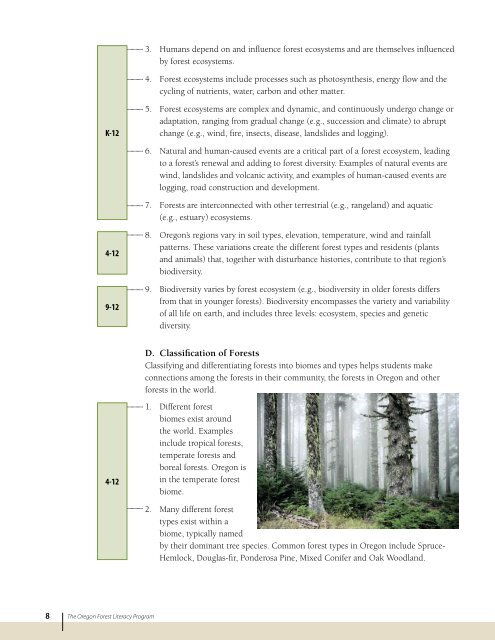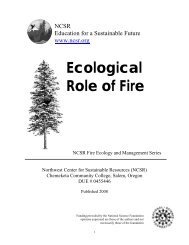Oregon Forest Literacy Program (PDF) - Learn Forests
Oregon Forest Literacy Program (PDF) - Learn Forests
Oregon Forest Literacy Program (PDF) - Learn Forests
Create successful ePaper yourself
Turn your PDF publications into a flip-book with our unique Google optimized e-Paper software.
K-12<br />
4-12<br />
9-12<br />
3.<br />
4.<br />
5.<br />
6.<br />
7.<br />
8.<br />
9.<br />
Humans depend on and influence forest ecosystems and are themselves influenced<br />
by forest ecosystems.<br />
<strong>Forest</strong> ecosystems include processes such as photosynthesis, energy flow and the<br />
cycling of nutrients, water, carbon and other matter.<br />
<strong>Forest</strong> ecosystems are complex and dynamic, and continuously undergo change or<br />
adaptation, ranging from gradual change (e.g., succession and climate) to abrupt<br />
change (e.g., wind, fire, insects, disease, landslides and logging).<br />
Natural and human-caused events are a critical part of a forest ecosystem, leading<br />
to a forest’s renewal and adding to forest diversity. Examples of natural events are<br />
wind, landslides and volcanic activity, and examples of human-caused events are<br />
logging, road construction and development.<br />
<strong>Forest</strong>s are interconnected with other terrestrial (e.g., rangeland) and aquatic<br />
(e.g., estuary) ecosystems.<br />
<strong>Oregon</strong>’s regions vary in soil types, elevation, temperature, wind and rainfall<br />
patterns. These variations create the different forest types and residents (plants<br />
and animals) that, together with disturbance histories, contribute to that region’s<br />
biodiversity.<br />
Biodiversity varies by forest ecosystem (e.g., biodiversity in older forests differs<br />
from that in younger forests). Biodiversity encompasses the variety and variability<br />
of all life on earth, and includes three levels: ecosystem, species and genetic<br />
diversity.<br />
4-12<br />
D. Classification of <strong>Forest</strong>s<br />
Classifying and differentiating forests into biomes and types helps students make<br />
connections among the forests in their community, the forests in <strong>Oregon</strong> and other<br />
forests in the world.<br />
1.<br />
Different forest<br />
biomes exist around<br />
the world. Examples<br />
include tropical forests,<br />
temperate forests and<br />
boreal forests. <strong>Oregon</strong> is<br />
in the temperate forest<br />
biome.<br />
2.<br />
Many different forest<br />
types exist within a<br />
biome, typically named<br />
by their dominant tree species. Common forest types in <strong>Oregon</strong> include Spruce-<br />
Hemlock, Douglas-fir, Ponderosa Pine, Mixed Conifer and Oak Woodland.<br />
8 The <strong>Oregon</strong> <strong>Forest</strong> <strong>Literacy</strong> <strong>Program</strong>



